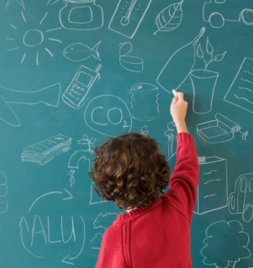Spirituality in Education
"What transforms
education, is a
transformed being in the world." Parker Palmer |
A more 'soulful' education seeks to open the mind, warm the heart and awaken the spirit of each student. It would provide opportunities for students to be creative, contemplative, and imaginative. It allows time to tell old and new stories of heroes, ideals and transformation. It encourage students to go deep into themselves, into nature, and into human affairs. It values service to others and the planet.
A spiritualized curriculum values physical, mental and spiritual knowledge and skills. It presents knowledge within cultural and temporal contexts, rather than as facts to be memorized or dogma to be followed. It is integrative across all disciplines emphasizing inter-relationship and inter-connectedness. It challenges students to find their own place in space and time, and to reach for the highest aspirations of the human spirit.
Books on Spirituality and
Spirituality in Education
| Zohar, D & Marshall, I. (2000). SQ: Connecting With Our Spiritual Intelligence. New York: Bloomsbury Publishing |
Walsh, Roger.
(1999)
Essential
Spirituality. New
York: John Wiley
|
Sloan, D. (1983) Insight-Imagination. Westport,
CT:Greenwood Press
|
|
Sinetar, M. (2000) Spiritual Intelligence: What We Can Learn
From The Early Awakening Child. New York: Orbis
|
Palmer,
Parker (1983) To Know As We Are
Known: A Spirituality of
Education. New
York:Harper Collins.
|
Moffet, J. (1994). The
Universal Schoolhouse: Spiritual
Awakening Through Education, San Francisco: Jossey-Bass Publishers
|
| Moore, T. (1994) Care of the Soul: A Guide for Cultivating Depth and Sacredness in Everyday Life. New York: HarperPerennial |
Moore, T. (2000)
Original
Self: Living with Paradox and Originality. New York: HarperCollins
|
Miller, J.P.
(1994) The Contemplative
Practitioner. Toronto:
OISE Press
|
|
Kessler, R. (2000) The
Soul of Education: Helping Students Find Connection, Compassion, and
Character at School Virginia:
ASCD
|
Glazer, Steven.
(1999)
The Heart of Learning: Spirituality in
Education.
New York: Tarcher/Putnam
|
Brussat, F. and M.
(1996)
Spiritual Literacy: Reading the
Sacred in Everyday Life. New York: Scribner
|
|
Pearmain, E.D. (Ed.) (1998) Doorways to the Soul: 52 Wisdom Tales
From Around The World Ohio: The Pilgrim
Press
|
Grof, C. (1993). The Thirst for Wholeness: Attachment,
Addiction and the Spiritual Path. San Francisco: HarperSan Francisco.
|
Tacey, David (2000)
Re-Enchantment: The New
Australian Spirituality. Sydney:HarperCollins
|
|
Palmer,
Parker (1998) The Courage to Teach: Exploring the inner landscape of a
teacher's life. San
Francisco: Jossey Bass.
|

Miller, John P. (2000) Education and the Soul: Toward a Spiritual
Curriculum. State University of New York Press
|
Nakagawa, Yoshiharu (2000)
Education for Awakening An
Eastern Approach to Holistic Education
Foundation for educational Renewal,
Brandon, VT
|
|
Nava, Ramon Gallegos.
Holistic Education: Pedagogy
of Universal Love
Great Ideas in Education
Box 328, Brandon, VT (Translated by Madeline Newman Rios and Gregory S. Miller) |
Miller, J & Nakagawa, Y (eds)
Nurturing Our Wholeness
Perspectives on Spirituality in Education Psychology Press/Holistic Education Press Box 328, Brandon, VT |

















 Students
are our future – whether they are just entering kindergarten or about
to graduate college, you can’t argue with that fact. So much time,
energy and money are spent on education to ensure that we are raising up
the leaders our world needs for tomorrow… According to the National
Center for Education Statistics Digest of Education Statistics of 2010,
the United States is home to some 140,000 schools (elementary, secondary
& post-secondary) and over 85 million students in public &
private schools. Educating our future leaders on the basics shouldn’t be
our only goal while they are in school – we should be setting an
example for them, including how we treat the environment. And we can
start by greening our schools.
Students
are our future – whether they are just entering kindergarten or about
to graduate college, you can’t argue with that fact. So much time,
energy and money are spent on education to ensure that we are raising up
the leaders our world needs for tomorrow… According to the National
Center for Education Statistics Digest of Education Statistics of 2010,
the United States is home to some 140,000 schools (elementary, secondary
& post-secondary) and over 85 million students in public &
private schools. Educating our future leaders on the basics shouldn’t be
our only goal while they are in school – we should be setting an
example for them, including how we treat the environment. And we can
start by greening our schools.
 Whether
you are a parent, teacher, superintendent or concerned citizen, we
suggest speaking to someone who has authority over your school about
improvements that could be made to address the green initiative while
also providing benefits to the school. The Green Schools Leadership
Center mentioned above is a great resource to look through as well as
checking out LEED credits that your school can earn through simple
adjustments. Though the GSLC was originally created to raise funding to
build new green schools, their resources have since expanded to offer help to existing schools looking to implement green processes wherever they can.
Whether
you are a parent, teacher, superintendent or concerned citizen, we
suggest speaking to someone who has authority over your school about
improvements that could be made to address the green initiative while
also providing benefits to the school. The Green Schools Leadership
Center mentioned above is a great resource to look through as well as
checking out LEED credits that your school can earn through simple
adjustments. Though the GSLC was originally created to raise funding to
build new green schools, their resources have since expanded to offer help to existing schools looking to implement green processes wherever they can. Whether in your restrooms or in your food service areas, the
Whether in your restrooms or in your food service areas, the  Earn LEED credits with the help of the
Earn LEED credits with the help of the  Keep your female teachers, teenage and adult students safe from bloodborne pathogens with the
Keep your female teachers, teenage and adult students safe from bloodborne pathogens with the